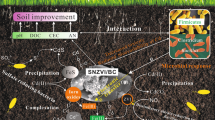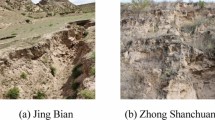Abstract
Phosphorus (P) leaching from a sandy soil was investigated in the presence of modified and unmodified clay minerals and nanoparticles (NPs). Compared with control soil, amended soil with NPs had the highest percentage of P retention than amended soil with clay minerals. Among the adsorbents used, the highest percentage of P retention was produced by Al2O3-chitosan while the lowest percentage of P retention was by zeolite. Data measured for P leaching after using adsorbents were used to predict P leaching using transport model. PHREEQC model was able to model P leaching from control and amended soil. After leaching, P values in control and amended soil were fractionated by a sequential extraction procedure. Concentration of P in Ca-bound fraction (HCl–P) after application of modified and unmodified clay minerals and NPs (except TiO2 and Al2O3) increased and decreased, respectively. Saturation indices (SIs) and P speciation were assessed using the Visual MINTEQ version 2.3 program. According to the SIs, leaching P from control and amended soil with different adsorbent was controlled by dissolution of hydroxyapatite. The results indicated that used adsorbents can reduce P leaching from the sandy soil. Thus, retention of P by amended soil reduced a risk in terms of groundwater contamination with P.




Similar content being viewed by others
References
Allison, J. D., Brown, D. S., & Novo-Gradac, K. J. (1991). MINTEQA2/PRODEFA2, A geochemical assessment model for environmental systems: Version 3.0 Users Manual. Athens: US Environmental Protection Agency. EPA/600/3–91/021.
Alvarez-Rogel, J., Jimenez-Carceles, F. J., & Egea-Nicolas, C. (2007). Phosphorus retention in a coastal salt marsh in SE Spain. The Science of the Total Environment, 378, 71–74.
Ann, Y., Reddy, K. R., & Delfino, J. J. (2000). Influence of chemical amendments on phosphorus immobilization in soils from a constructed wetland. Ecological Engineering, 14, 157–167.
Beck, M. A., Robarge, W. P., & Buol, S. W. (1999). Phosphorus retention and release of anions and organic carbon by two Andisols. European Journal of Soil Science, 50, 157–164.
Borggaard, O. K., Jörgensen, S. S., Moberg, J. P., & Raben-Lange, B. (1990). Influence of organic matter on phosphate adsorption by aluminium and iron oxides in sandy soils. Journal of Soil Science, 41, 443–449.
Börling, K., Otabbong, E., & Barberis, E. (2001). Phosphorus sorption in relation to soil properties in some cultivated Swedish soils. Nutrient Cycling in Agroecosystems, 59, 39–46.
Boruvka, L., & Rechcigl, J. E. (2003). Phosphorus retention by the Ap horizon of a spodosol as influenced by calcium amendments. Soil Science, 168, 699–706.
Bower, C. A., & Wilcox, L. V. (1965). Soluble salts. In: C. A. Black (Ed.), Methods of soil analysis part 2, chemical and microbiological properties. Pub. NO. 9. American Society of Agronomy. p. 933-951.
Brookins, D. G. (1988). Eh-pH diagrams for geochemistry. New York: Springer-Verlag.
Camargo, J. A., Alonso, A., & de la Puente, M. (2005). Eutrophication downstream from small reservoirs in Mountain Rivers of Central Spain. Water Research, 39, 3376–3384.
Chen, G. C., He, Z. L., Stoffella, P. J., Yang, X. E., Yu, S., & Calvert, D. (2006). Use of dolomite phosphate rock (DPR) fertilizers to reduce phosphorus leaching from sandy soil. Environmental Pollution, 139, 176–182.
Colvin, V. L. (2003). The potential environmental impact of engineered nanomaterials. Nature Biotechnology, 21, 1166–1170.
Devau, N., Hinsinger, P., Le Cadre, E., Colomb, B., & Gé Rard, F. (2011). Fertilization and pH effects on processes and mechanisms controlling dissolved inorganic phosphorus in soils. Geochimica et Cosmochimica Acta, 75, 2980–2996.
Doshi, R., Braida, W., Christodoulatos, C., Wazne, M., & O’Connor, G. (2008). Nano-aluminum: transport through sand columns and environmental effects on plants and soil communities. Environmental Research, 106, 296–303.
Dou, Z., Zhang, G. Y., Stout, W. L., Toth, J. D., & Ferguson, J. D. (2003). Efficacy of alum and coal combustion by-products in stabilizing manure phosphorus. Journal of Environmental Quality, 32, 1490–1497.
Elliot, H. A., O’Connor, G. A., & Brinton, S. (2002a). Phosphorous leaching from biosolids amended sandy soils. Journal of Environmental Quality, 31, 681–689.
Elliot, H. A., O’Connor, G. A., & Brinton, S. (2002b). Influence of water treatment residuals on phosphorous solubility and leaching. Journal of Environmental Quality, 31, 1362–1369.
Esteller, M. V., Martínez-Valdés, H., Garrido, S., & Uribe, Q. (2009). Nitrate and phosphate leaching in a Phaeozem soil treated with biosolids, composted biosolids and inorganic fertilizers. Waste Management, 29, 1936–1944.
Fang, J., Shan, X. Q., Wen, B., Lin, J. M., & Owens, G. (2009). Stability of titania nanoparticles in soil suspensions and transport in saturated homogeneous soil columns. Environmental Pollution, 157, 1101–1109.
Freeman, J., & Rowell, D. (1981). The adsorption and precipitation of phosphate onto calcite. Journal of Soil Science, 32, 75–78.
French, R. A., Jacobson, A. R., Kim, B., Isley, S. L., Penn, R. L., & Baveye, P. C. (2009). Influence of ionic strength, pH, and cation valence on aggregation kinetics of titanium dioxide nanoparticles. Environmental Science and Technology, 43, 1354–1359.
Geng, B., Jin, Z., Li, T., & Qi, X. (2009). Kinetics of hexavalent chromium removal from water by chitosan-Fe0 nanoparticles. Chemosphere, 75, 825–830.
Gustafsson, J. P. (2005). Visual MINTEQ ver 2.32. Royal institute of technology, Stokholm, Sweden, Dapartment of land and water resources engineering. http://hem.bredband.net/b108693.
Hansen, J. C., & Strawn, D. G. (2003). Kinetics of phosphorus release from manure-amended alkaline soil. Soil Science, 168, 869–879.
Havlin, J. L., Beaton, J. D., Tisdale, S. L., & Nelson, W. L. (1999). Soil fertility and fertilizers: An introduction to nutrient management (p. 499). New York: Prentice Hall.
Heckrath, G., Brooks, P. C., Poulton, P. R., & Goulding, K. W. T. (1995). Phosphorous leaching from soils containing different P concentrations in the Broadbalk experiment. Journal of Environmental Quality, 24, 904–910.
Hedley, M. J., Stewart, J. W. B., & Chauhan, B. C. (1982a). Changes in inorganic and organic soil phosphorus fractions induce by cultivation practices and by laboratory incubation. Soil Science Society of America Journal, 46, 970–976.
Hedley, M. J., White, R. E., & Nye, P. H. (1982b). Plant-induced changes in the rhizosphere of rape (Brassica napus var. Emerald) seedlings. III. Changes in L value, soil phosphate fractions and phosphatase activity. New Phytologist, 91, 45–56.
Holford, I. C. R., & Mattingly, G. E. C. (1975). Phosphate sorption by Jurassic Oolitic limestone. Geoderma, 13, 257–264.
Hughes, J. H., & Gilkes, R. J. (1984). The effect of chemical extractant on rock phosphate fertilizer dissolution. Australian Journal of Soil Research, 22, 475–481.
Jalali, M. (2009). Phosphorous concentration, solubility and species in the groundwater in a semi-arid basin, southern Malayer, western Iran. Environmental Geology, 57, 1011–1020.
Jalali, M., & Kolahchi, Z. (2009). Effect of irrigation water quality on the leaching and desorption of phosphorous from soil. Soil and Sediment Contamination, 18, 576–589.
Jalali, M., & Ranjbar, F. (2011). Effect of addition of organic residues on phosphorus release kinetics in some calcareous soils of western Iran. Environmental Earth Sciences, 62, 1143–1150.
Jalali, M., & Varasteh Khanlari, Z. (2011). The impacts of common ions and electrolyte concentration on the release of P from some calcareous soils. Arid Land Research and Management, 25, 217–233.
Johnson, G. V., Raun, W. R., Zhang, H., & Hatteery, J. A. (1997). Oklahoma soil fertility hand book (4th ed.). Stillwater: Dep. Of Agronomy, Oklahoma State Univ.
Kalbasi, M., & Karthikeyan, K. G. (2004). Phosphorus dynamics in soils receiving chemically treated dairy manure. Journal of Environmental Quality, 33, 2296–2305.
Karageorgiou, K., Paschalis, M., & Anastassakis, J. N. (2007). Removal of phosphate species from solution by adsorption onto calcite used as natural adsorbent. Journal of Hazardous Materials, 139, 447–452.
Kolahchi, Z., & Jalali, M. (2013). Phosphorus movement and retention by two calcareous soils. Soil and Sediment Contamination, 22, 21–38.
Kordlaghari, M. P., & Rowell, D. L. (2006). The role of gypsum in the reactions of phosphate with soils. Geoderma, 132, 105–115.
Kretzschmar, R., Barmettler, K., Grolimund, D., Yan, Y., Borkovec, M., & Sticher, H. (1997). Experimental determination of colloid deposition rates and collision efficiencies in natural porous media. Water Resources Research, 33, 1129–1137.
Kuligowski, K., & Poulsen, T. G. (2009). Phosphorus leaching from soils amended with thermally gasified piggery waste ash. Waste Management, 29, 2500–2508.
Li, Z., Jean, J. S., Jiang, W. T., Chang, P. H., Chen, C. J., & Liao, L. (2011). Removal of arsenic from water using Fe-exchanged natural zeolite. Journal of Hazardous Materials, 187, 318–323.
Linquist, B. A., Ruark, M. D., & Hill, J. E. (2011). Soil order and management practices control soil phosphorus fractions in managed wetland ecosystems. Nutrient Cycling in Agroecosystems, 90, 51–62.
Lu, P., & O’Connor, G. A. (2001). Biosolids effects on P retention and release in some sandy Florida soils. Journal of Environmental Quality, 30, 1059–1063.
Maguire, R. O., & Sims, J. T. (2002). Measuring agronomic and environmental soil phosphorus saturation and predicting phosphorus leaching with Mehlich 3. Soil Science Society of America Journal, 66, 2033–2039.
Mahdavi, S., Jalali, M., & Afkhami, A. (2012). Removal of heavy metals from aqueous solutions using Fe3O4, ZnO, and CuO nanoparticles. Journal of Nanoparticle Research, 14, 1–18.
Mahdavi, S., Jalali, M., & Afkhami, A. (2013). Heavy metals removal from aqueous solutions using TiO2, MgO, and Al2O3 Nanoparticles. Chemical Engineering Communications, 200, 448–470.
Moharami, S., & Jalali, M. (2013). Removal of phosphorus from aqueous solution by Iranian natural adsorbents. Chemical Engineering Journal, 223, 328–339.
Moharami, S., & Jalali, M. (2014). Effect of TiO2, Al2O3 and Fe3O4 nanoparticales on phosphorus removal from aqueous solution. Environmental Progress Sustainability. In Press.
Murphy, P. N. C. (2007). Lime and cow slurry application temporarily increases organic phosphorus mobility in an acidic soil. European Journal of Soil Science, 58, 794–801.
Murphy, J., & Riley, J. P. (1962). A modified single solution method for determination of phosphate in natural waters. Analytica Chimica Acta, 27, 31–36.
Navarro, E., Baun, A., Behra, R., Hartmann, N. B., Filser, J., Miao, A. J., et al. (2008). Environmental behavior and ecotoxicity of engineered nanoparticles to algae, plants and fungi. Ecotoxicology, 17, 372–386.
Olsen, S. L., & Sommers, L. E. (1982). Phosphorus In: A. L. Page et al. (Eds.), Methods of soil analysis, part 2 (pp. 403–427), 2nd ed. Agron. Monogr. No. 9, Madison WI: ASA and SSSA.
Pan, G., Krom, M. D., & Herut, B. (2002). Adsorption–desorption of phosphate on airborne dust and riverborne particulates in East Mediterranean seawater. Environmental Science and Technology, 36, 3519–3524.
Parkhurst, D. L., & Appelo, C. A. J. (1999). User’s guide to PHREEQC (version 2)-A computer program for speciation, batch-reaction, one-dimensional transport, and inverse geochemical calculations. United States Geological Survey, Water Resources Investigations Report 99-4259, Washington, p 326.
Rowell, D. L. (1994). Soil science: Methods and applications. Harlow: Lingman Group.
Saleh, N., Kim, H. J., Phenrat, T., Matyjaszewski, K., Tilton, R. D., & Lowry, G. V. (2008). Ionic strength and composition affect the mobility of surface-modified Fe0 nanoparticles in watersaturated sand columns. Environmental Science and Technology, 42, 3349–3355.
Sawhney, B. L. (1977). Predicting phosphate movement through soil columns. Journal of Environmental Quality, 6, 86–89.
Sui, Y., Thompson, M. L., & Shang, C. (1999). Fractionation of phosphorus in a Mollisol amended with biosolids. Soil Science Society of America Journal, 63, 1174–1180.
Tunesi, S., Poggie, P., & Gessa, C. (1999). Phosphate adsorption and precipitation in calcareous soils: the role of calcium ions in solution and carbonate minerals. Nutrient Cycling in Agroecosystems, 53, 219–227.
USEPA (2007). Nanotechnology white paper. Prepared for the U.S. Environmental Protection Agency by Members of the Nanotechnology Workgroup, a Group of EPA’s Science Policy Council Science Policy Council. U.S. Environmental Protection Agency, Washington, DC.
Wiesner, M. R., Lowry, G. V., Alvarez, P., Dionysiou, D., & Biswas, P. (2006). Assessing the risks of manufactured nanomaterials. Environmental Science and Technology, 40, 4336–4345.
Yang, J., He, Z., Yang, Y., Stoffella, P., Yang, X., Banks, D., et al. (2007). Use amendments to reduce leaching loss of phosphorus and other nutrients from a sandy soil in Florida. Environmental Science and Pollution Research International, 14, 266–269.
Author information
Authors and Affiliations
Corresponding author
Rights and permissions
About this article
Cite this article
Moharami, S., Jalali, M. Phosphorus leaching from a sandy soil in the presence of modified and un-modified adsorbents. Environ Monit Assess 186, 6565–6576 (2014). https://doi.org/10.1007/s10661-014-3874-7
Received:
Accepted:
Published:
Issue Date:
DOI: https://doi.org/10.1007/s10661-014-3874-7




